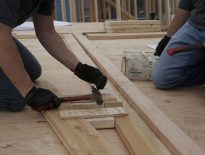Exploring the Living Building Challenge Affordable Housing Pilot Program
The Living Building Challenge (LBC) and Affordable, Urban Infill Housing
Midrise urban apartment buildings, especially those rented or sold below market-rate, are a special building type to consider in the context of imagining a Living Future. These buildings define “home” for dozens or hundreds of households at a time and set the context for community; at a regional scale, establishing healthy, safe, and inclusive housing is the first step in ensuring strong and resilient cities.
And yet, this building type has historically been one of the more elusive to sustainable design. Affordable housing is often located in challenging infill sites, built with minimal setbacks and constrained orientation, and is sometimes subject to high noise and air pollution from the surrounding environment. The program of efficient apartment housing has a high amount of infrastructure (HVAC, plumbing, and appliances) in relation to overall gross square footage and to roof area. There is the challenge of unpredictable residential behavior and rudimentary maintenance of central systems. Often between four and nine stories, it’s a stretch to provide enough solar power to cover the projected energy use of such a project, although not technically impossible in certain climates.
Above all, perhaps, affordable housing is a special challenge because it is fairly conventional. These projects don’t tend to attract high-profile consultants. They face aggressive schedules, value engineering, and strict development requirements. A tight construction market can drive up premiums for higher quality products that can’t be recovered through increased rents. Our non-profit clients are tasked with the incredible challenge of not only funding affordable housing, but also balancing the allocation of precious dollars towards critically needed homes with the mission of making these homes as healthy and sustainable as possible.
And So The LBC Framework for Affordable Housing
The challenges of affordable housing have become a focal point for the International Living Future Institute (ILFI), which places social equity as a cornerstone of a Living Future. In 2014, the Institute convened a number of stakeholders to study and produce a pilot program and framework for certifying affordable housing projects. The framework includes some high-level technical feasibility analysis and provides a few exceptions to LBC 3.0/3.1 – most notably, affordable housing projects may rely more on municipal infrastructure for potable water, stormwater, and blackwater treatment, provided a design has been created showing how to site-source 100% of the building’s potable water demand in the future. For multi-family, affordable housing greater than three stories in height, an exception also exists that allows for a connection to a municipal sewer system for blackwater treatment.
With our client, Resources for Community Development (RCD), David Baker Architects (DBA) joined the second phase of the Affordable Housing Pilot Program in 2015 with Coliseum Place, a six-story, 59-unit affordable family apartment building in East Oakland, California. The pilot program has allowed us to share feedback, roadblocks, and resources with similar project teams, as well as learn from ILFI and the other pilot teams.
When Coliseum Place was denied its first funding request in 2016, RCD used the schedule gap as an opportunity to conduct a feasibility analysis of the LBC for the project, using a grant from Enterprise Community Partners. Along with water and energy consultants, Hyphae Design and Integral Group, DBA set out to identify Imperatives that would push us beyond our standard practice of sustainable design without a major increase in scope, and to do a deeper investigation of design solutions that would be necessary to meet the more challenging Petals of Energy, Water, and Materials.
Below we summarize what we discovered about the LBC through this process and, more generally, about the value of such aspirational frameworks when designing in dense, urban communities.

Which Imperatives are “Easy” and Why
We first assigned a compliance difficulty level to each imperative, based on how we typically work with a non-profit affordable housing developer. We were pleasantly surprised to discover that, by our judgment, over half of the 20 Imperatives would be achievable within the existing project scope, and of these, our design already complied with five. Certain Imperatives, like “01 – Limits to Growth” or “07 – Civilized Environment” are inherent to the project’s status as an infill residential and community-focused development. Others, like providing active, tree-lined pedestrian edges and embedded parking, DBA would do as best practice, although the LBC also stretched our thinking a bit further on these measures.
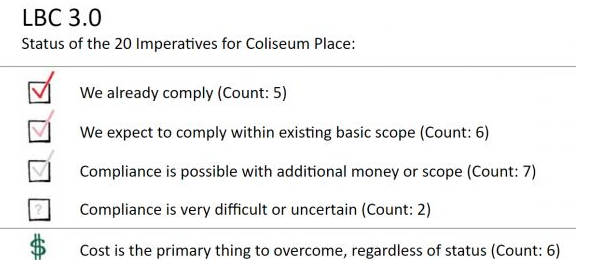
Which Imperatives Present a Design Opportunity
This class of Imperatives reveals the immediate value of the LBC to an architectural practice like ours, which produces a new iteration on the urban mid-rise housing type with every project. Between the group of Imperatives that one can take for granted and those that are truly challenging, this class of Imperatives can push a team to think about ordinary design conversations in a new way or to expand upon certain design opportunities. A good example is 09 – Biophilic Environment. To be honest, some of us cringe at the term Biophilia; too often it feels like the word has disembodied fairly common sense ways of connecting humans to nature and replaced them with pseudo-scientific or superficial gestures. Still, without a framework that forces us to pause and articulate our intentions for bringing residents closer to nature and creating a quality indoor environment, these are the very design features that can get glossed over, value engineered out, or simply not receive an equivalent level of design thinking. DBA takes pride in how our projects achieve what some might call biophilia, and there is always room to deepen this commitment.
To comply with Imperative 09, the project team needs to submit a Biophilic Design “plan” that articulates a response to the cultural, ecological, and climatic context of the project and explains how it “nurtures the innate human/nature connection.” For Coliseum Place, although the required eight-hour all-hands charrette did not feel like a responsible use of time within our resources, schedule, and design constraints, we did set aside a dedicated meeting where we invited key consultants to reflect on the site context, articulate design goals, and brainstorm ways that we could approach existing building features – such as on-podium treatment planters and a courtyard connection – in ways that could further enhance resident experience of site and ecology.
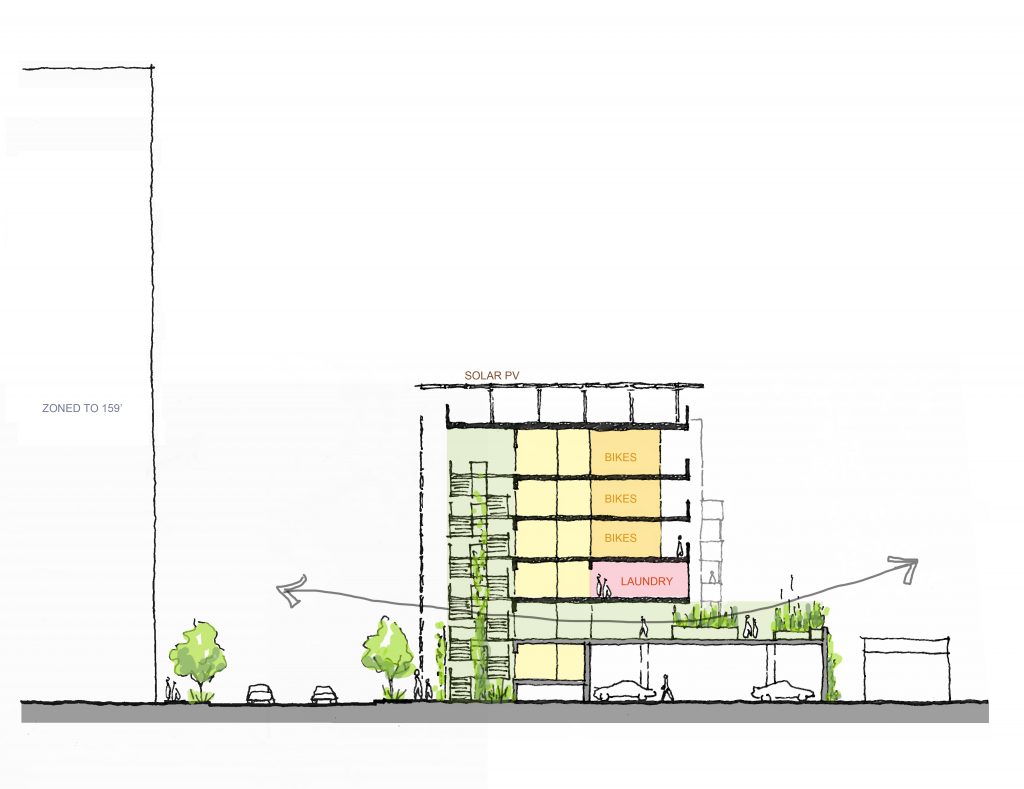
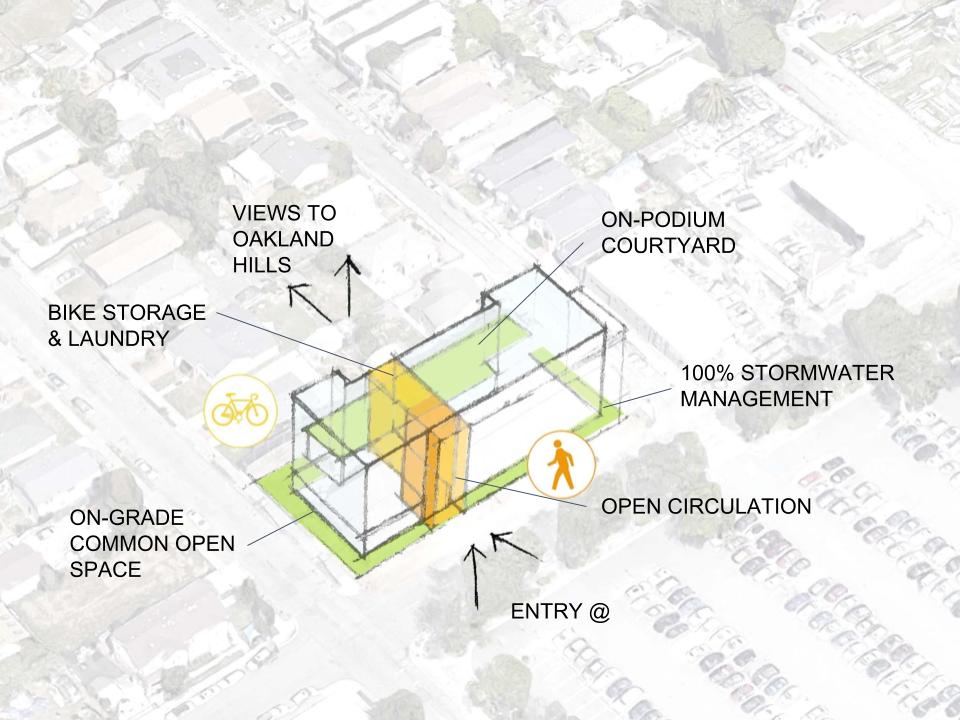
Which Imperatives Are a Bit of a Stretch (Things that Add Scope and Soft Cost)
This class of Imperatives would clearly add value to the project, if only a bit of extra investment could be mustered. Examples include creating a design energy model to evaluate a whole-building energy budget (typically compliance with energy code drives our understanding, which is imperfect at best); installing systems with high upfront cost but very low operating costs; or monitoring indoor air quality. Also in this category are Imperatives that simply take time and fee to document – such as carbon accounting, the detailed sourcing of all materials on the project, and waste diversion – and although these practices have a clear benefit to the environment, they don’t yield as direct or obvious a return for the project.
We found the Imperative 06 – Net Positive Energy to be technically possible for Coliseum Place, but ambitious. In consultation with our energy and mechanical consultants, Redwood Energy and EDesignC Engineers, we determined that getting there for this six-story building would require making some different decisions about envelope, building systems and, most likely, some creative facilitation of resident behavior. Well over a third of the total building’s energy use will be determined by residents’ use of appliances, lighting, and other plug loads. On the plus side, three simple decisions within the designer’s control carry the lion’s share of the work and they came with no up-front cost: 1) making the building all-electric, 2) designing a decentralized hot water system with no recirculation loop; and 3) creating a tight envelope with efficient, in-unit balanced ventilation. With LED lighting, Energy Star appliances, and an efficient, common laundry already assumed, these final decisions brought the energy budget within spitting distance of what our roof could accommodate. At this point, the larger question of how much PV was a smart, defensible investment for a non-profit owner took over, and our final solution will be, if nothing else, a studied balancing act weighing constructability and cost of an elevated PV array as compared to the value recovered by allocating PV to residents and operating cost considerations.
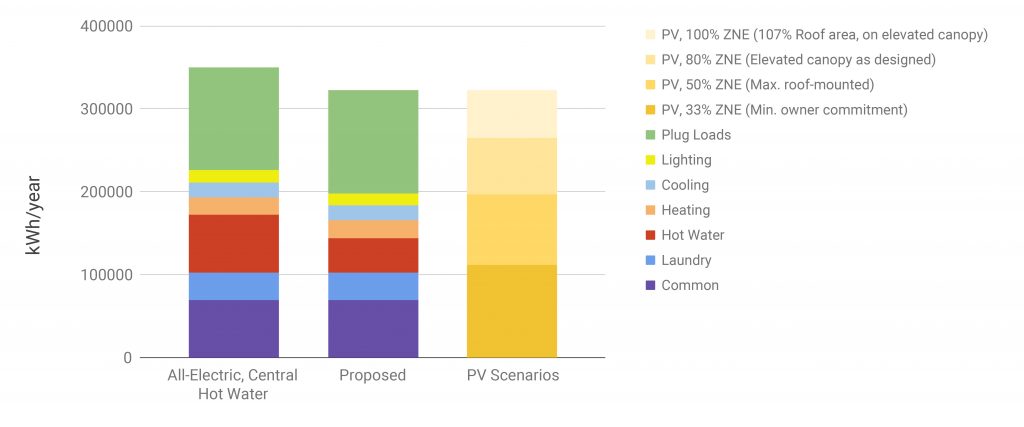
Which Imperatives are Costly and Uncertain
Imperatives in this and the previous categories are on a fairly subjective spectrum from “costs a little extra” to “this is not happening,” and that calculus would probably change project to project or even over the life of a single project as priorities and budgets shift. For the Coliseum Place project, we cited cost as a primary obstacle for six of the 20 Imperatives. For only two Imperatives did we feel compliance was too difficult to achieve or determine on this project – 05 – Net Positive Water and 10 – Red List. The Materials Imperatives, especially the Red List, are a challenge primarily because they entail making a commitment to a process of research with an uncertain outcome and uncertain cost implications.
The Red List has been one of the LBC’s most transformative initiatives – a story of early-adopter magnanimity and a committed industry working together as an organism – and the Institute’s efforts over the past several years to target products common in affordable housing has been no exception. After over a decade of market transformation and LBC teams sharing their research, overcoming the Red List is not as great an obstacle as it used to be. In particular, ILFI has released several resources to specifically give affordable housing projects a major head start with vetted product lists and draft specifications tailored for material decisions that typically arise in housing. ILFI has recently collaborated with Integrated Eco-Strategy who produces the Red2Green Tool, an interactive database that allows project teams to share and upload product disclosure information in real time and provides templates intended to streamline the process. As DBA continues materials research for Coliseum Place, this tool has made the task more accessible.
Still, even as soft cost demands decline, achieving a Red List-free project is daunting, with a number of persistent sticking points, and stubbornly pervasive toxic products that are often used in affordable housing because they are cheap and offer the “bullet-proof” building durability prioritized by property managers. The beauty of the Red List, however, is that you don’t have to pursue the Materials Petal to make sure your project at least captures some low-hanging fruit, and/or uses available resources to target materials that have high impact in either scope (there’s a lot of it), or health and environment (it’s particularly bad), or both.
The major technical and cost challenge for Coliseum Place was meeting 05 – Net Positive Water – even with the exceptions that are allowed under the LBC Framework for Affordable Housing. Although you can certify a project without site-sourced potable water under the Framework, the future provision of site-sourced water assumes that a complying building design will start with some amount of rainwater collection. Meanwhile, a building like Coliseum Place, with a high number of units per acre and very little open space, generates more greywater than it knows what to do with. Showers alone provide more than enough supply to serve the legal non-potable demand (toilets, laundry, and irrigation). Additionally, the rainwater available on site would never be enough to provide for the potable demand, like sinks, showers and dishwashing, without some real outside-the-property-line creativity. In theory, we do in fact have an unusual opportunity at Coliseum Place to allocate some space in the building for a 30,000 gallon rainwater cistern (which would bring us to 62% potable demand reduction), and we can explore creative ways of getting to zero—for example, an approach which ILFI calls “ Handprinting” in which we would use excess greywater to offset the potable water use of neighboring properties and claim that offset for our project.
To reduce potable water demand, however, we found that the cost-benefit curve got very steep once we moved beyond efficiency measures alone. Designing for the future provision of 100% site-sourced water took the project in an entirely different design direction and resulted in some odd conclusions, such as using a turn-key blackwater-to-potable treatment system like the “Aquacell,” which in many ways would be the simplest approach. However, including a wastewater treatment system within a building such as this sent up a red flag for our team. Hyphae Design, who has studied the application of such systems at different scales, found that, on a site-by-site basis, it could use 4-8 times the energy it would take to perform the same task at a municipal scale.
Ultimately, the costs and logistical challenges involved in full compliance with the Water Petal in the context of this multi-family project in East Oakland were not something the design team could overcome. Allowing the building to process and treat the high volumes of greywater required by this project type in addition to collecting rainwater felt to us to be a significant burden to place on a property management operation that is relatively unsophisticated. In another construction market (or water value paradigm), investing in on-site greywater reuse could be a viable design option as it would substantially improve the resilience of such a property. Similarly, allowing remaining greywater to be treated on site and thereby alleviating impact on the municipal sewer system also has real value. These were all exciting measures to explore, even though they were deemed too expensive in the end to implement for this project.
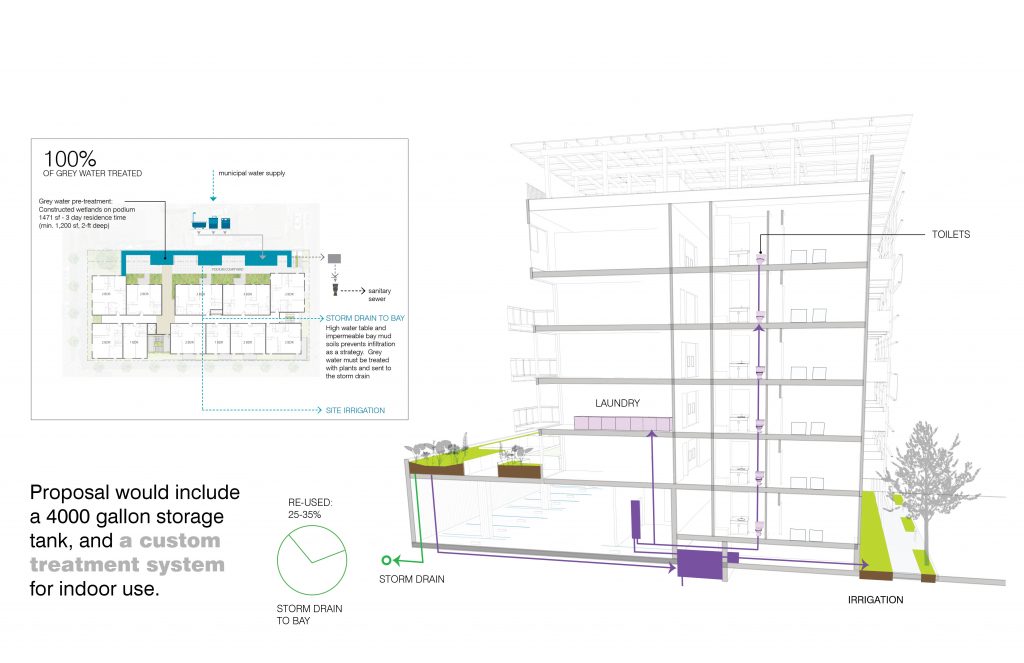
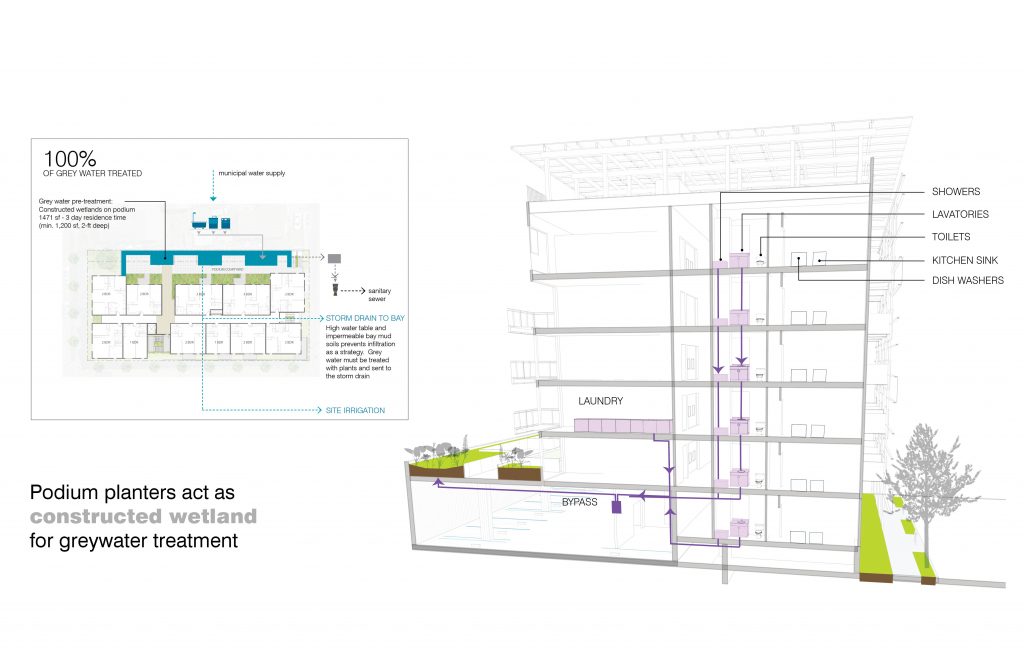
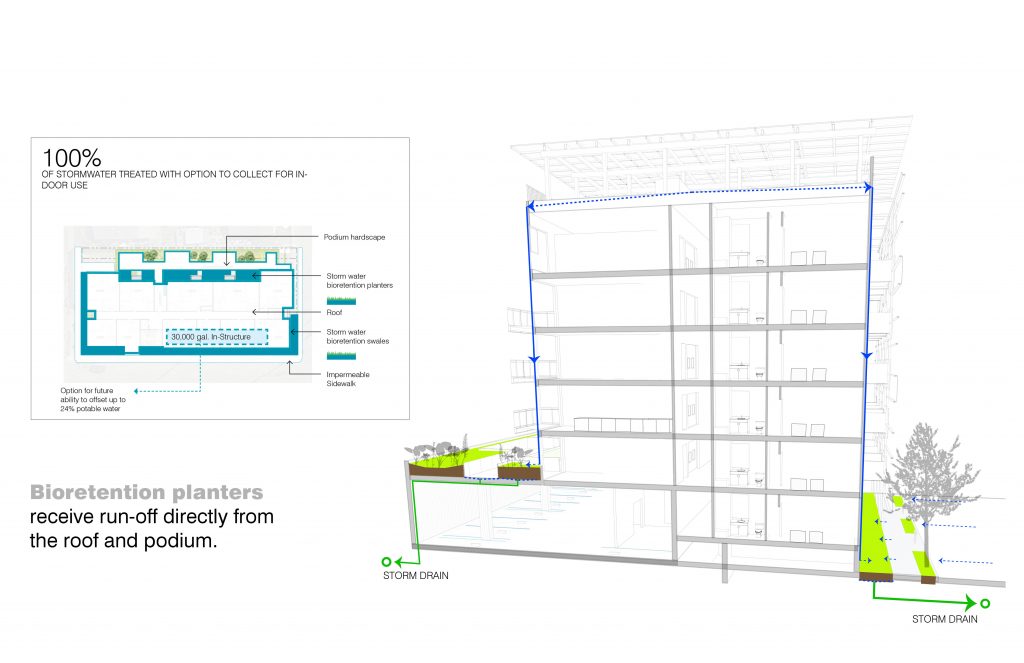

The Take-Away
For an affordable housing project, it is critical that any cost premium to meet the LBC come with a commensurate direct benefit to the core mission of promoting stable and resilient urban communities through housing. In the purest incarnation of its vision, the Living Building Challenge promotes these same goals and poses no cost burden, which is part of the reason for the existence of the Affordable Housing Pilot Program. DBA’s desire to promote knowledge and tools to alleviate cost impacts to the LBC within the affordable housing industry was part of our impetus to join the program.
For our team, evaluating the benefits of high-cost LBC items came down to asking whether the cost significantly improves the quality of the homes and the experience, health, and resilience of the residents and their community. These assessments are not easy to judge. But the power of the LBC is that it compels a design team to commit – earnestly – to trying to ensure that their building is what good looks like. By using the Living Building Challenge as a framework, we can prioritize those solutions that have the highest value based on a new, more inclusive set of rules. For instance, through our analysis we learned that electrification, combined with eliminating hot water recirculation, has perhaps the greatest impact of any individual measures on overall carbon over 20 years for no added cost, and that a tight envelope is the single most cost-effective way to reduce resident loads. These benefits are realized regardless of whether we ultimately match total energy demand with on-site generation. There is also a value proposition to be made in drought-sensitive California to pursue on-site greywater treatment in order to reduce potable water use for irrigation and toilet flushing, and to promote innovation and conservation in the community. Although these measures were ultimately eliminated from Coliseum Place due to budget, we at least created a basis for discussion beyond up-front construction costs alone.
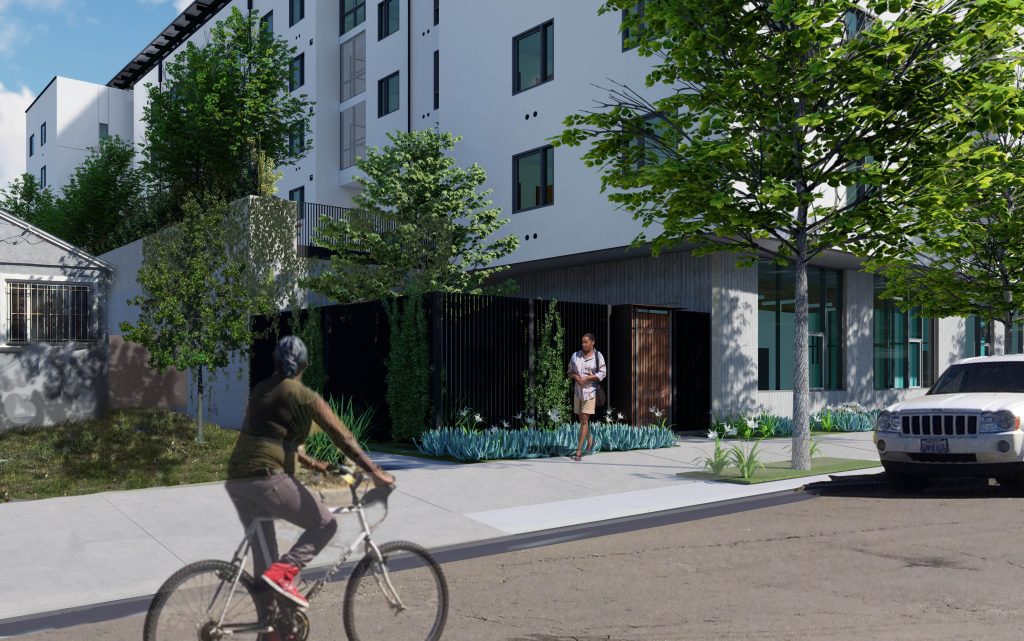
Some affordable housing pilot teams enter the process not believing that they will completely achieve Living or Petal certification, but for aiming high, they have gotten much further in their commitments to reduced energy consumption and increased reliance on on-site generation, reduced water use and increased water reuse, and inclusion of healthy materials than they would have otherwise, and thereby have raised the bar in their thinking for all future projects. This was our team rationale in entering the pilot in 2015. Last year, ILFI kicked off Round 3 of its pilot program, and we are happy to have a second project participating in the pilot: Hunters View Phase III in San Francisco, CA. There are many good reasons to pursue the Living Building Challenge. Because we gave ourselves some space to do the initial legwork – by turning a funding shortfall into an opportunity – we learned things about our project type and regulatory environment that we didn’t already know, even after designing dozens of similar projects. We are also excited about the opportunity to use the LBC on both Hunters View III and Coliseum Place as a method for framing their project narratives, goals, and decision-making to get further than we would with a business-as-usual process. And should Coliseum Place not achieve Energy Petal certification, this new knowledge does not disappear, but can be transferred and leveraged to make each new project in our portfolio better. Due to our experiences with LBC and the Affordable Housing Pilot Program, we are in an improved position to advocate for strategies that didn’t work for Coliseum Place due to finances, timing or regulations, but may make sense in another scenario. This allows us to challenge conventional wisdom from a more informed place, as well as identify new opportunities as regulations and products in the market open new doors.
To hear more about LBC and affordable housing, join Katie and ILFI at Living Future 2019! Katie will be speaking at Progress to the Summit on Wednesday, May 1st from 8 AM to 12 PM and Informed Design for Zero-Carbon Urban Housing on Friday, May 3rd from 2 PM to 3:15 PM. To learn more about our other affordable housing pilot projects, join ILFI during Housing Development Consortium’s Affordable Housing Week, May 13th-17th, where we will be co-hosting a tour of Hopeworks Station Phase II and holding a panel discussion of healthy materials for affordable housing featuring the Othello Square project in South Seattle.


